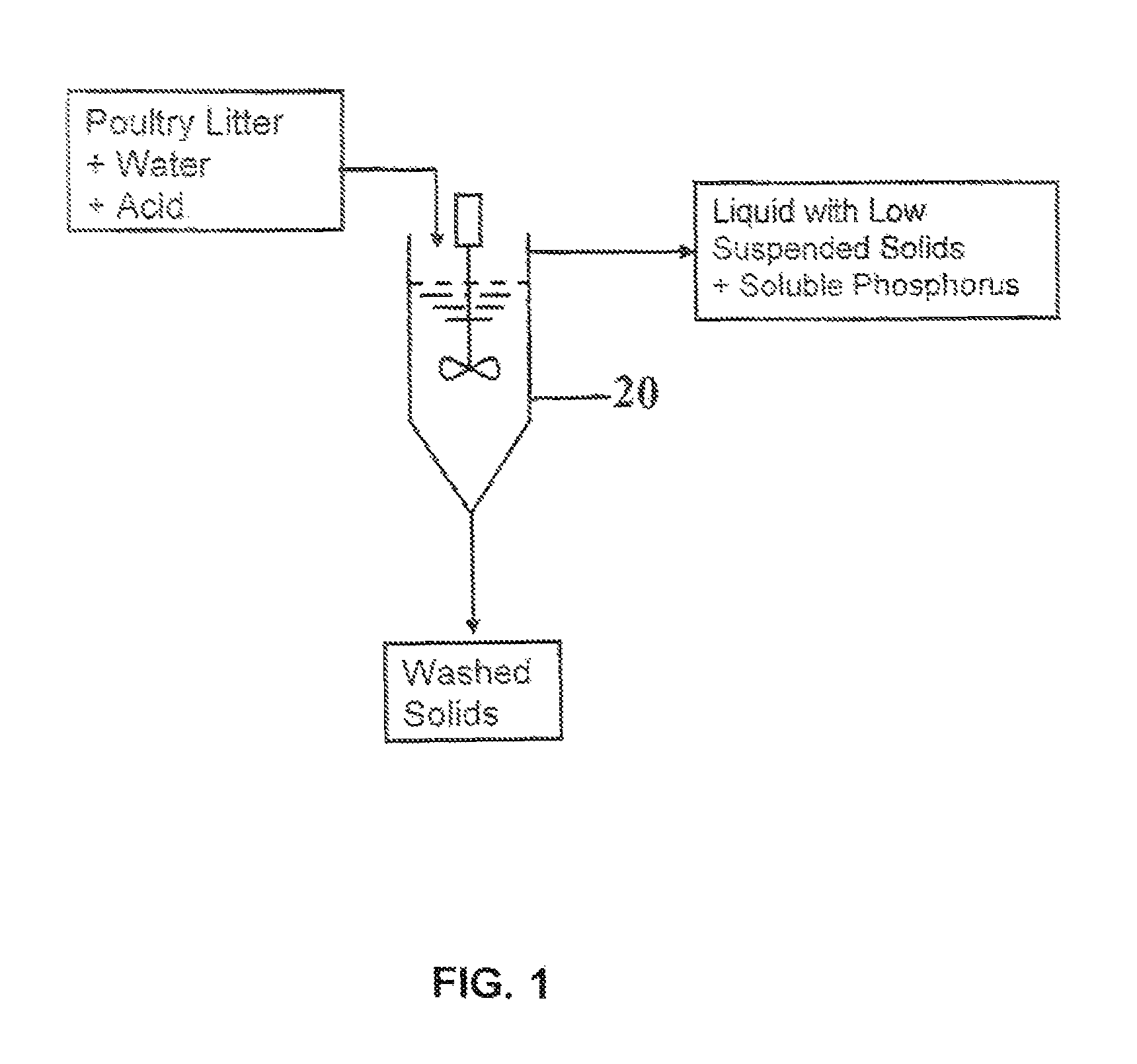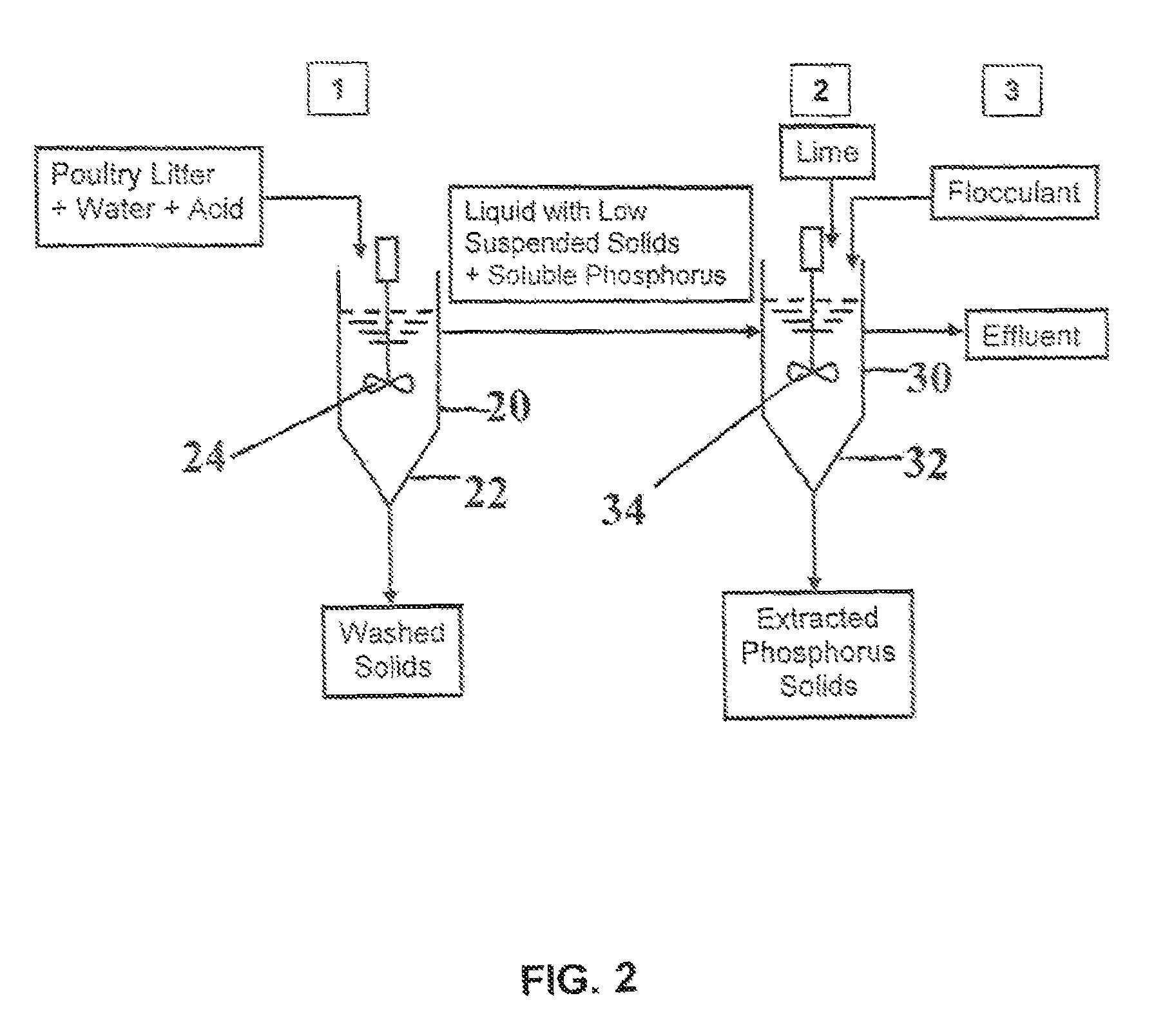Process for removing and recovering phosphorus from animal waste
a technology for animal waste and phosphorus, which is applied in the field of extracting and recovering phosphorus from animal waste, can solve the problems of high density of animals, high cost, and risk of animal production, and achieves the effects of reducing the number of animals in the confined environmen
- Summary
- Abstract
- Description
- Claims
- Application Information
AI Technical Summary
Benefits of technology
Problems solved by technology
Method used
Image
Examples
example 1
[0039]Organic and inorganic acids were tested for their potential to extract phosphorus from poultry litter. Poultry litter samples were prepared by grinding and passing through a sieve of about 5.8 mm. Aqueous solutions of acetic, citric, and hydrochloric acids were added to about 2.00 grams of ground and sieved poultry litter samples in a ratio of about 1:2.5 w / v at concentration levels of about 0, 2.5, 5, 10, 20, 40, and 80 mmoles / liter. The solutions and litter were mixed in a reciprocating shaker at about 135 oscillations / minute at ambient temperature of about 23° C. for approximately 1 hour. Subsequently solids and liquid were separated by centrifuge at about 2000×g for about 5 minutes. The liquid supernatant was decanted and analyzed for pH, total phosphorus (TP), and total Kjeldahl nitrogen (TKN). Solids were air dried at about 40° C. and analyzed for total Kjeldahl and total phosphorus. The experiment was repeated and the treatment control consisted of extraction with disti...
example 2
[0047]To demonstrate the removal and recovery of phosphorus from the liquid extract, which includes steps 2 and 3 of the process, generated by litter washing (step 1) (FIG. 2), approximately 64 grams of poultry litter, as prepared in Example 1, was mixed with approximately 1.6 liters of 20 mM citric acid solution in a ratio of 1.25 w / v and stirred for about one hour with a magnetic stirrer. After the mixture settled for about 20 minutes, the liquid extract was separated from washed litter by decantation and transferred to separate laboratory vessels. To one half of the vessels, hydrated lime (Ca(OH)2) was added, to the other half, lime and flocculant was added. Hydrated lime in water was added in various amounts until the pH of the mixed liquid reached set points of approximately 6, 7, 8, 9, 10, or 11 units (Treatments 1-6, respectively); a control treatment with no lime addition was included (Treatment 0). The recovery of phosphorus was enhanced by adding an organic flocculant to c...
example 3
[0054]A field prototype system was developed to evaluate the process of the present invention to extract and recover phosphorus from poultry litter. The system included two connected reactor vessels (FIG. 3). The extraction vessel 20 in the sequence was the phosphorus extraction reactor that consisted of an approximately 378-liter tank with a conical bottom 22, a mixer 24, and a pH controller (not shown). Once liquid reacted with solids, stirring was stopped to let solids settle. After settling of solids, the supernatant from tank 20 was pumped to a second vessel, a phosphorus removal tank 30. The tank 30 in the sequence was the phosphorus recovery reactor that consisted of a second about 378 liter tank with a conical bottom 32, mixer (not shown) and pH controller (not shown). The unit was completed with a smaller 115 gallon tank (not shown) with a mixer and pump used to stir and inject the hydrated lime solution into the tank 30. Solid and liquid sampling was done in duplicate. Pho...
PUM
 Login to View More
Login to View More Abstract
Description
Claims
Application Information
 Login to View More
Login to View More - R&D
- Intellectual Property
- Life Sciences
- Materials
- Tech Scout
- Unparalleled Data Quality
- Higher Quality Content
- 60% Fewer Hallucinations
Browse by: Latest US Patents, China's latest patents, Technical Efficacy Thesaurus, Application Domain, Technology Topic, Popular Technical Reports.
© 2025 PatSnap. All rights reserved.Legal|Privacy policy|Modern Slavery Act Transparency Statement|Sitemap|About US| Contact US: help@patsnap.com



